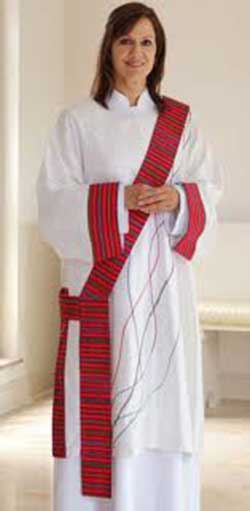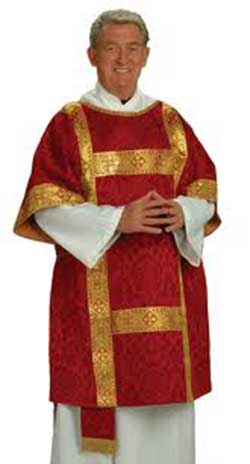 I have received requests to go through the Peace in slow motion, particularly which parts are appropriate for the presider to do and which parts are appropriate for the deacon to do (if one is part of leading the service).
I have received requests to go through the Peace in slow motion, particularly which parts are appropriate for the presider to do and which parts are appropriate for the deacon to do (if one is part of leading the service).
In my book Celebrating Eucharist I have a section on The deacon at a Eucharist in my chapter on Leading Worship.
This has that the deacon’s “roles include introducing the confession, proclaiming the Gospel and sometimes preaching, providing leadership for the Prayers of the People, inviting the congregation to exchange the Peace, preparing the holy table and setting the bread and wine upon it, assisting at the elevation at the end of the Great Thanksgiving, helping distribute the bread and wine, and dismissing the congregation.” [Emphasis for this post].
The Roman Rite has:
The Priest, turned towards the people, extending and then joining his hands, adds:
The peace of the Lord be with you always.
The people reply:
And with your spirit.
Then, if appropriate, the Deacon, or the Priest, adds:
Let us offer each other the sign of peace.
And all offer one another a sign, in keeping with local customs, that expresses peace, communion, and charity. The Priest gives the sign of peace to the Deacon or minister.
- the presider initiates the dialogue of the Peace
- extending hands is the gesture that goes with the presider’s words; the gesture is in silence, and precedes the words
- the deacon invites the congregation to exchange the Peace
- no gesture is specified to go with the deacon’s invitation
- if there is no deacon, the invitation, in the Roman Rite, is done by the priest
Compare this with the Anglican Rite as exemplified in A New Zealand Prayer Book He Karakia Mihinare o Aotearoa (NZPB/HKMA) p.419
All standing, the presiding priest says to the people
The peace of Christ be always with you.
Kia tau tonu te rangimarie o te Ariki ki a koutou.
And also with you.
A ki a koe ano hoki.
The people and presiding priest may exchange a sign of peace according to local custom.
[The other rites in that Prayer Book all follow the same format. Even A Form for Ordering the Eucharist p.511, a framework format, has that “The people and presiding priest Exchange the Peace”. NZPB/HKMA is always as broadly permissive as possible, restricting to the presider only what is seen as most strictly required.]
From this we have
- the presider initiates the dialogue of the Peace
- no gesture is indicated. IMO extending hands is the obvious gesture; holding a book, addressing a book, is inappropriate; the model of gestures in NZPB/HKMA is consistently – gesture in silence followed by words
- no words of invitation are given; “Let us offer each other the sign of peace” or similar appear to me to be an invitation that may be used, alternatively (following eg. Ceremonies of the Eucharist: A guide to Celebration
p.148) the exchange of peace follows directly after the people’s response with no further invitation required to be added to the rite
- IMO if a deacon is present in leadership of the service, the deacon proclaims these words invitation, if such words are added to the rite; the presider does not usurp this diaconal role
I would love someone to add in the comments the form this takes in Orthodoxy.




As liturgy dominates the title of this post I should not be surprised at its frequent appearance. However, while once following this site with great interest, I now glance at it often with disinterest. Please enlighten me why liturgy is so central to “worship”, coming to grips with the ideas of god. It does not appear to have been central with Jesus and a number of prophets are quite explicit about its abuse and inconsequence.
I very much like properly performed Evensong from the Book of common Prayer. I use to admire a well performed Latin Mass. But on reflection this admiration is more aesthetic than anything else. And talking to any number of people in depth this applies to most of them even if not realised. In fact When I observe many at Evensong I see people at a concert. And i look at this post, admire the beautiful fancy dress and wonder what it has to do with the mystery and me.
Of course the Hill Song type worship is also a concert.
The older I grow and more and more frequently i am dissatisfied. Francis while still a cardinal said something along the lines thaeop Catholic lay people too often found it easier to be altar servers than real followers of Jesus.
Take away from me the noise of your songs; I will not listen to the melody of your harps. But let justice roll down like waters, and righteousness like an ever-flowing stream. — Amos 5:21-24
Thanks, Brian; good, important questions – that probably require a post (or a series of posts) for a fuller response.
Liturgy = community worship.
I see no evidence that Jesus did not participate in the normal community worship of his faith, in fact quite the opposite, this participation, and the ongoing participation in community worship appears to be just taken for granted throughout the New Testament.
All good things can be abused: money, sex, nature, knowledge. Liturgy. I do not follow from the abuse of these goods to the consequence being we should abandon the good.
Blessings.
Thank you Bosco. It is a subject more and more on my mind and I appreciate, sympathize with what you have said.
Interestingly I recently had a long talk with a Bishop’s wife in which she described much of the liturgy she goes to as meaningless. She much prefers a regular Quaker type gathering she attends.
In many places I visit, as well as others I hear about, Brian, I can so sympathise with that person. Blessings.
In the Orthodox Church the priests (if there are more than one) exchange the kiss of peace within the altar, while the deacons (if there are more than one) do so outside, before the holy doors, kissing the cross on each other’s oraria (stoles).
Thanks, Steve. So there is nothing comparable to the western practice of a peace greeting in the assembly? Blessings.
Oh there is indeed something comparable, or perhaps incomparable. Back in 1968 I attended the Orthodox Paschal Vigil for the first time, and observed (and indeed took part in) the Easter Kiss. It lasted at least 45 minutes.
It made a strong impression on me, because there was nothing comparable in the West. Back then there was the Kiss of Peace at High Mass, when the priest, deacon and subdeacon would hold each other’s elbows. Nobody else did. The author of Ritual Notes discussed the proptiety of an “actual osculation” but seemed to dismiss it as either unnecessary or impractical.
For a description of the Orthodox practice, see Christian community — what is it? | Khanya.
The Easter Kiss is preceded, at the beginning of Lent, by the Vespers of Forgiveness on Forgiveness Sunday (also called Cheesefare Sunday), when everyone prostrates themselves in front of everyone else and asks for forgiveness, and gives and receives forgiveness, each saying to the other “Forgive me” as they bow down (kneeling, head touching the floor), and “I forgive you” as they rise and kiss each other (twice for Greeks, three times for Russians).
It’s tough. You can feel forgiveness in your thighs right through the first week of Lent. But even tougher is saying the actual words, “I forgive you”. Many people chicken out and slip into the impersonal passive — “You are forgiven”. Others slip even further, and say “Have a good Lent.”
As the Orthodox Church currently celebrates the Divine Liturgy, the “kiss of peace” takes place before the recitation or singing of the Creed, with this bit of dialogue:
Presbyter: “Peace be to all!”
Congregation: “And with your spirit.”
Deacon: “Let us love another, so that with one mind we may confess…”
Congregation: “Father, Son and Holy Spirit! The Trinity, one in essence and undivided!”
The call to “love another” is supposed to be the cue for the exchange of the “kiss of peace.” However, nowadays, it is mostly exchanged only among the clergy concelebrating in the sanctuary, with a three-fold kiss and this exchange: “Christ is in our midst!” “He is and ever shall be!” In some places, the kiss of peace (or some gesture like a handshake or a hug) among the laity at this point in the Divine Liturgy is being revived, but it is not widespread.
Thanks so much, Gregory. Blessings.
I have never understood theexchange” of the Peace of Christ, as theologically, it is not mine to exchange (as if a gift “exchange,” but a passing-on, or better yet a sharing-in-together (koinonia) of the Peace of Christ, as if passing the Light of the Paschal Candle to a candle and then that light is shared with all others in the roo, not an exchange of the lights in our hands. I was taught in seminary that the priest shared the peace from the Altar, with the Deacons, who psassed it to another ano passed it to anothe tile all had “received” or shared-together-in (St. Paul’s syn- in Greek) the Peace of Christ from the Altar. From there it is taken out into the world, just as the Light of Christ is taken out into the world. I miss that. Today, the Peace in most churches I have beeen in (all over the country) has become a “hi-how are-you” and gossip catch-up time which takes longer than partaking of the elements. In several churches I have OFTEN, ofgten seen guest leave thinking it is the end of the service. Really!!! But then too, I am old fashioned. Thank goodness my kind are retired and don’t mess things up for all the changes.
Thanks, Joel. You may be interested in what I write about the Peace in my book. Blessings.
This seems to me to be sound thinking. Although I do not think it necessary (nor do the Anglican books apparently) to issue an additional invitation to share some sign of the peace, if one is to do so it is a diaconal function, as it is the deacon who serves as liturgical “traffic director” in giving directions to the gathered assembly. (The one exception I can think of is the Sursum Corda itself, at least as it stands in our present liturgies.)
Thanks, Tobias. Although it is not in our book, I would think it is very common to have such an additional invitation given in services here. Blessings.